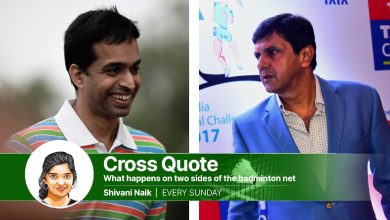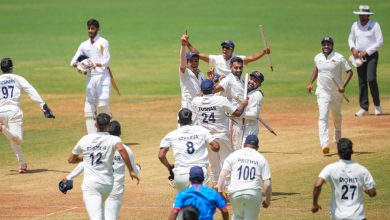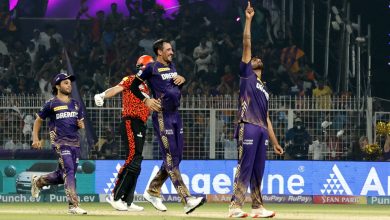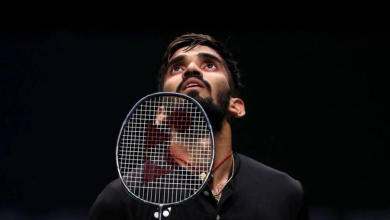Long Read: US colleges are the finishing school for elite athletes. Should more Indians be taking advantage?

When Tejaswin Shankar’s first American scholarship offer to play in the National Collegiate Athletic Association (NCAA) arrived, he was in disbelief. “I thought it was some sort of scam. Aapko koi leke bhi jaa raha hai, padha bhi raha hai, rakh bhi raha hai, aur sab kuchh free mein,’ (Your travel, education and stay are all free). I thought it was some sort of kidnapping racket,” he told The Indian Express earlier this month.
Later, as he realised that he will be part of a system of over 500 schools, each of which specialises in a different sport, in the top collegiate competition in the world, he has become an advocate of it.
“If it’s free and we can use it, why are we relying on the government to spend crores of rupees on sports budgets? Trust your athletes to come back home and perform at a high level,” he said.
Tejaswin’s conviction has paid off. The 23-year-old high jumper’s bronze at the recent Commonwealth Games was one of a whopping 45 medals won athletes coming through the NCAA system, in track and field alone. As many as 21 of those medals were gold, in varied events like sprints, marathons, discus throw, and triple jump. The medalls come from all over the world, from Africa and the Caribbean, as well as the UK and Australia.
Somdev Devvarman. (FILE)
Today, American colleges are full of international student-athletes who are finding huge success. At the NCAA Outdoor Track and Field Championships in Eugene this year, 15 champions came from countries outside the United States, including Tunisia, St Lucia, Morocco, and Zimbabwe.
One of those 15 champions was Tejaswin. The high jumper is a six-time All-American athlete and set the Indian national record of 2.29m while competing for Kansas State University in 2018. At the Hayward Field, he became just the second Indian to win two NCAA championships, alongside Somdev Devvarman.
Devvarman himself is one of just 13 players to have ever won consecutive Division 1 tennis titles at that level, the second of which saw him post a win-loss record of 44-1. Less than a year later, he became the first Indian since Leander Paes to reach the final of an ATP event at the Chennai Open, where he had entered the main draw as a wildcard.
Tejaswin studied business adminration at the Kansas State University on a four-year scholarship.(File)
Devvarman is another advocate of young Indians taking the American scholarship route. He clarifies, however, that the sport one plays must be taken into consideration: track and field, golf, tennis, and swimming are all at an elite level in the NCAA, but sports like badminton or table tennis are not.
The former top 70 player told The Indian Express that there are things he learned and unlearned – on and off the court – while going through the system, without which he was not likely to become the player that he became.
“I think a big question any athlete, or person in general, must ask themselves is ‘what are your parameters for success?’ Do you define success as just winning medals or trophies? Because I’ll be honest, that’s not how I saw it,” he said.
“I joined the University of Virginia back in 2004, which was a top division 1 programme under the NCAA. But I was not very confident that I would be able to go pro. What mattered to me was just having the freedom to play. To do what I knew best. And over there, with the structure and organisation they gave me, everything from strength coaches to taking care of my nutrition, I felt I got that freedom,” he said.
On his way to the NCAA title in 2007, Devvarman defeated future two-time Grand Slam final Kevin Anderson in the semifinal, and then future top-10 player and US No.1 John Isner in the final. He believes that the exposure he gained, to train and compete with some of the world’s best young players, was crucial to his development.
“At the 2006 US Open, Andre Agassi, in the final match of his career, lost the third round to Benjamin Becker (of Germany). In my first year here, Becker won the NCAA title with Baylor (University). I remember watching that match and thinking: ‘If he can do it, so can we.’”
Success breeds success, and one found plenty of success stories in the NCAAs, he said.
Breeding ground for medalls
The track record of athletes that have come through the NCAA system, especially the internationals who often play on scholarships, seems to vindicate Devvarman’s view.
Tejaswin and he are not the only high-profile athletes to go the NCAA way. In the late 1960s, triple jumper Mohinder Singh Gill went through the system before winning Commonwealth and Asian Games medals. Discus thrower Vikas Gowda was the 2004 NCAA champion, and 10 years later, won a Commonwealth Games gold in Glasgow. And today, athletes in a variety of disciplines are taking part.
But Devvarman believes more Indians eligible for scholarships should be taking advantage of the structure that the NCAA can provide. “For any athlete, the most difficult jump is going from a successful junior career to the pros. There is a huge leap in between. That period is usually when they are at university, between the ages of 18 and 22. Playing consently and looking after your body at that time is so crucial,” he said.
Devvarman announced his retirement from the tour in 2017, and while many may associate him with broadcasting now, he had a brief stint as a coach in Germany, where he worked with promising young Indians like Sumit Nagal and Karman Kaur Thandi, whom he feels could have benefitted from the support he had at that age.
“They (Karman and Sumit) have struggled with injuries. I remember going through the same in that phase. But in Virginia, I had dedicated training rooms, I could get scans done, get the right rehabilitation process, the right advice, the right training regimen.
“Frankly, in India, this can be quite hard. The whole ecosystem does not ex, and if you want to create it, you have to pay exorbitant costs,” the former tennis player said.
An athlete’s career is short, he says, and in their developmental years, they are one ill-timed injury away from failing to reach the heights they can. In those years, having a support system can be crucial.
“I wish more people made the smarter decision. And more importantly, I wish more people knew about the choices they have,” Devvarman added.
Discus thrower Vikas Gowda was the 2004 NCAA champion, and 10 years later, won a Commonwealth Games gold in Glasgow. And today, athletes in a variety of disciplines are taking part.
For all the evident opportunities an NCAA scholarship may provide though, the lack of accessibility is a challenge.
There are various divisions in the system, and getting a top-level Division 1 scholarship involves cut-throat competition, not just on the field, but academically too. Most schools have qualifying criteria for their scholarships, which include competitive test scores as well as minimum cut-off scores at all levels of senior schooling. It requires a certain level of academic inclination and command over the English language which a national junior champion, who does not come from a privileged background, may not have.
There are financial constraints too. Schools at the top of the competitive curve are likely to give 100 percent scholarships only to a high-level recruit, and it is even rarer for international students. So, if financial aid is the primary concern, a student-athlete may have to choose a lesser school, which could be detrimental to their development, to make sure their education and training does not come at too high a price.
Tejaswin’s case also highlights an apprehension of Indian sports bodies. The Delhi-based athlete was snubbed the Athletics Federation of India for the Asian Championships back in 2019, failing to recognise his results in the US after he missed the Federation Cup. Ahead of the CWG this year, barring a last-minute court intervention, hory was about to repeat itself.
Devvarman puts these constraints into perspective before advising young athletes to pursue the same route as him. He maintained that, in his experience, the focus in the NCAA is on developing well-rounded athletes, which has value beyond sport.
“It depends on what your priorities are. A lot of student-athletes I trained with realised they can’t make it to the top, or don’t want to. They went on to find success in other things in life, for which a great education opened doors for them. But if winning medals and competing at the top is the priority, and 100 percent scholarships are not on the table, these things must be kept in mind,” he said.
AT CWG 2022, Track and Field:
· A total of 45 medals were won athletes produced the NCAA system. Of those, there were 21 gold medals.
· The top countries to benefit:Nigeria – 10 medals, 5 goldJamaica – 8 medals, 2 goldTrinidad – 5 medals, 4 goldCanada – 3 medals, 3 GoldAustralia – 3 medals, 2 Gold
· India’s Tejaswin Shankar won the bronze medal in men’s high jump.
Full break-up: In CWG 2022 Track & Field, medals won athletes that have come through NCAA
Country
Gold
Total
Ghana
0
2
Nigeria
5
10
St Lucia
0
1
England
2
3
Jamaica
2
8
Barbados
1
2
Trinidad
4
5
Australia
2
3
Bahamas
1
2
Bermuda
0
1
Grenada
1
2
Canada
3
3
Scotland
0
1
New Zealand
0
1
India
0
1
Total
21
45







